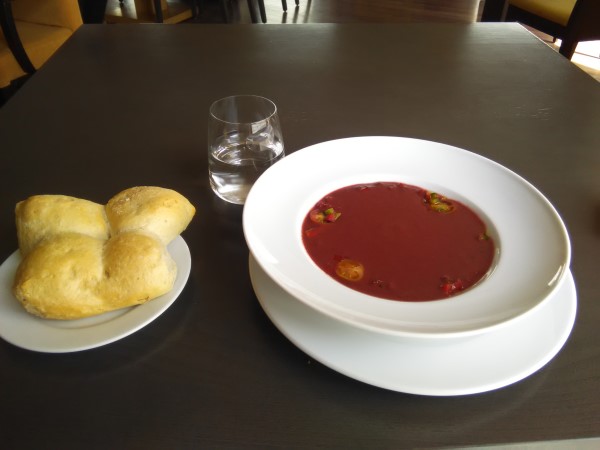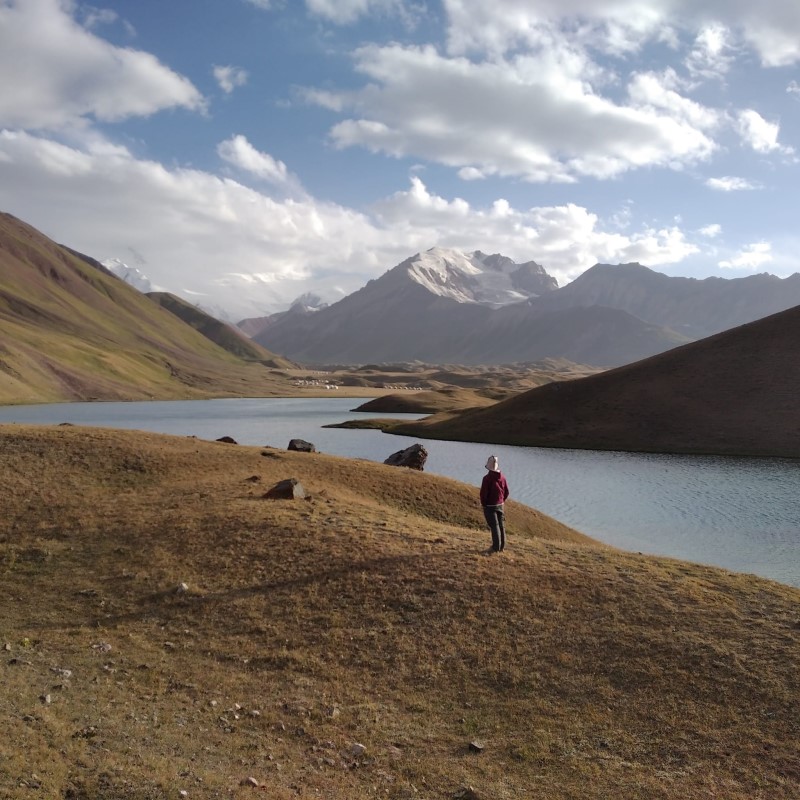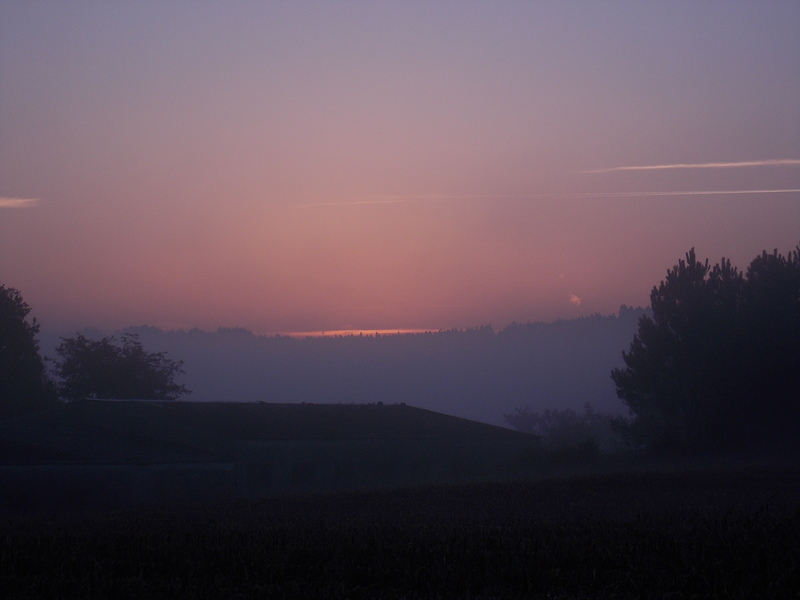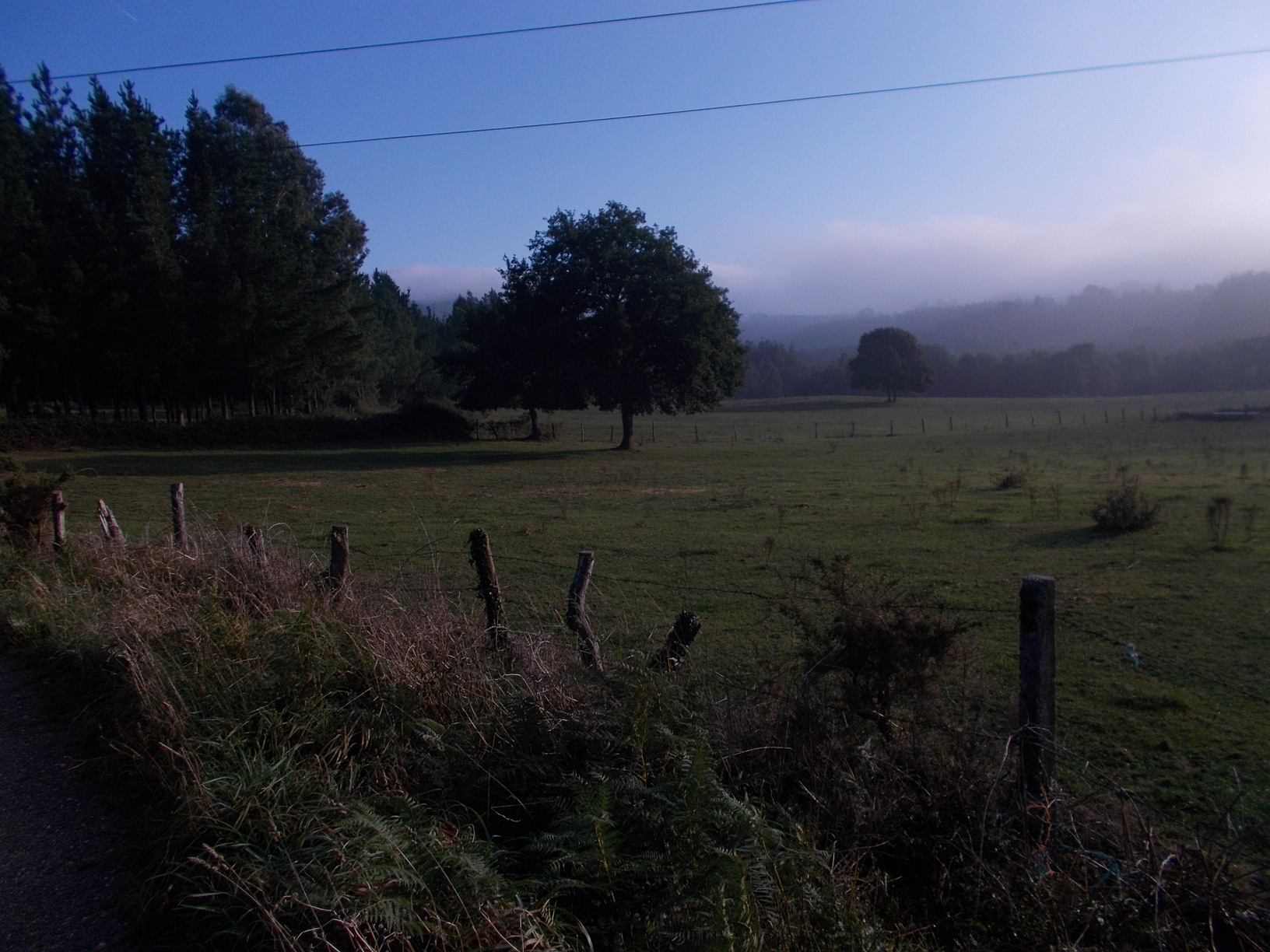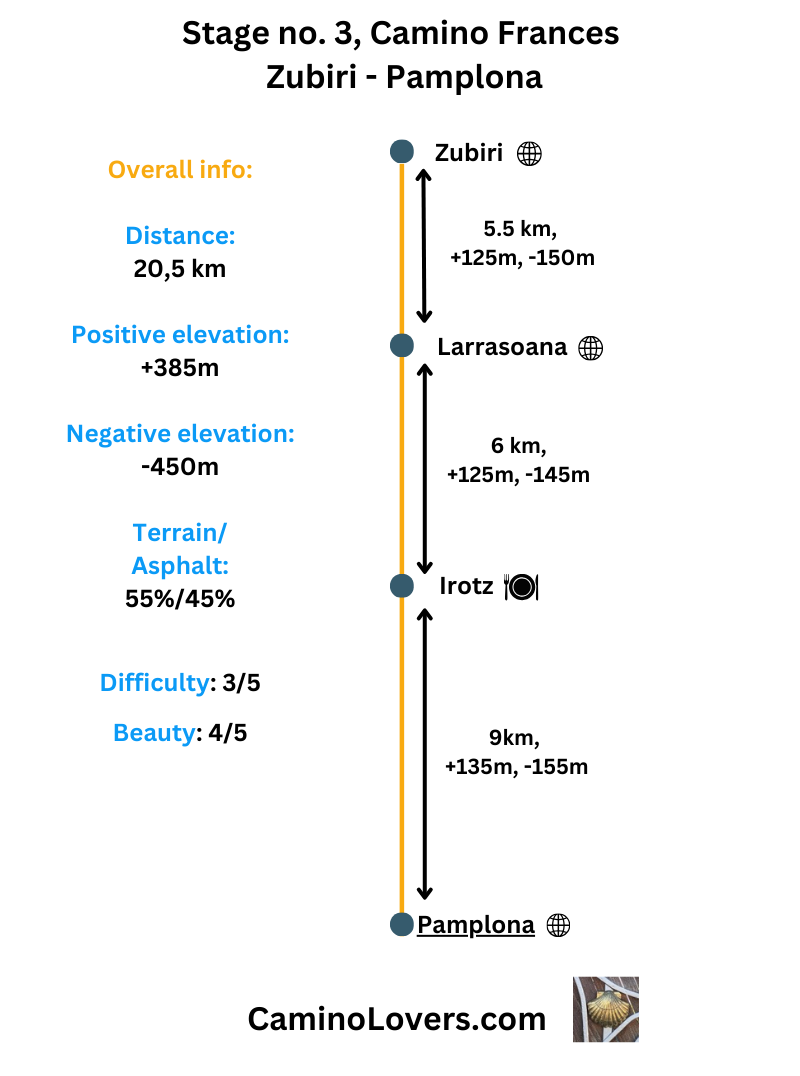
Basic Information
- Starting Point: Zubiri, Spain – A small town in the Basque Country, known as the “town of the bridge” due to its iconic medieval bridge over the Rio Arga. Count with six pilgrim albergues (1 big and 5 small), various hotels and restaurants, and all facilities for pilgrims.
- Ending Point: Pamplona, Spain – The capital of Navarre, famous for its historic old town, Gothic cathedral, and the Running of the Bulls festival. A big town with over 200,000 inhabitants, with everything good and bad you can find in any big city. Due to its popularity it often gets extremely crowded from spring to summer. Not recommended for an extra day of rest.
- Availability of alternative route: Not really, unless we speak about a small ‘river detour’ at the end before Pamplona, which it quite popular by pilgrims nowadays. In my opinion though, it doesn’t add much, especially because you already had a much nicer river walk starting from Zubiri. Anyway, the detour is well marked, and you can see it on the map here if you want.
- Distance: 20.5 km (download GPS here)
- Online Map: View the route here.
- Elevation Difference: +380 m ascent, -450 m descent
- Difficulty Score: 3/5
- Beauty Score: 4/5 – Scenic riverside path, charming villages, and lush countryside, finishing in a big town of Pamplona, which can either be a high point or a low point, depending on whether you like the cities :). Anyway, overall this is a nice stage.
- Terrain/Asphalt Walking Ratio: 55% trails, 45% asphalt/paved roads or right next to paved roads.
- Next stage: Camino Frances Stage no. 4, Pamplona – Puente de la Reina.
- Previous stage: Camino Frances Stage no. 2, Roncesvalles – Zubiri.
Elevation Profile for the route

– As you can see, although you follow a river flow for most of the day, it isn’t plain sailing. Sometimes you go closer to the river and sometimes farther, with relatively steep climbs here and there, always followed by another descend. Compared to the previous two stages, however, the profile is definitely easier.
Advanced Info About the Stage
- Trail Marking: Be careful at the start of today’s stage, and especially if you leave Zubiri by dark. You have to walk back and cross the medieval bridge over Rio Arga (the one you used yesterday to enter the city), and then at the end of the bridge turn right. From there on, the trail is well marked and you should not get lost. When you get close to any of the small villages, you will always see yellow arrows pointing to bars, albergues, etc. You can ignore them if you want to simply continue on the main path. If you want to follow the river variant the last few kilometers to Pamplona, the turning point is exactly here. Instead of crossing the bridge (where the official camino goes), you simply continue walking along the same river bank. The trail is marked with pointers saying “Paseo Fluvial“.
- Natural Places Worth Seeing:
- Rio Arga: The river accompanies you for much of the stage, offering peaceful views with a lot of variety. Some small waterfalls at the start, even some nice rapids. Then it flattens out and widens and there’s more vegetation and birds, and you can simply enjoy the peaceful sound of water flowing as your day and life flows by…
- A viewpoint near Akerreta. Location on Google maps here. Maybe the nicest viewpoint on today’s stage, near a small church in a small settlement called Akerreta. Just 100 meters detour from the Camino, worth taking.
- Historical, Architectural, and Culinary Places Worth Seeing:
- Countryside Villages: Pass through charming villages like Larrasoaña and Trinidad de Arre, each with its own unique character, colors, flags. Camino passes through some of these directly, for others you’ll have to make a small detour. If you’re not in rush, it is definitely worth it.
- Trinity Bridge, location on Google maps here. A nice medieval bridge, the one place where everyone takes pictures today :). It is also an exact spot where the river-side variant detours from the official camino. What many people do not know is that the beautiful building at the end of the bridge actually hosts a pilgrim albergue, with 32 places. If you prefer to avoid the buzz and rush of Pamplona, you can stay here for the night. Location and reviews on Google maps here.
- Iglesia de San Nicolás (Pamplona): The nicest Romanesque church in Pamplona, with beautiful architecture and paintings. If you’re into churches, this is the one to visit. Free entry, open 7 days a week.
- Pinchos: Many Spanish cities boast about having the best pinchos (small finger foods) in Spain. Pamplona is no exception to the rule. And while in my opinion it is impossible to pick a winner, and the pinchos in one place aren’t necessarily better than in the next one, it is definitely worth trying some with your pilgrim friends.
- Camping/Bivouac Options on the Stage: There aren’t any official camping places, organized or wild, along today’s stage. There is one called camping Ezcaba, but it is 3.5 km away from the Camino, overpriced, and with not the best reputation… You can check it on Google maps here if you want, but I do not recommend this option. Your best bet for wild camping is on a small hill just before Pamplona, with the ruins of castle Miravalles, exactly here. To reach the place, you make a detour from the Trinity bridge. Explore the zone on the top, there is a small chapel, a cross, and some nice flat ground. Just make sure to pitch your tent only in the evening, because during the day some locals always jog/walk here. I highly discourage you from an idea of bivouacking in some park in the town of Pamplona. The town is just too busy for that, police doesn’t like it at all, too many drunkards around, etc. Simply not a good idea…
- Dog-Friendly Score: 3/5. A mix really. The first 15 kilometers are super nice, with water always around, plenty of shade, good paths for dogs. Then the big urban zone starts… Obviously in a town as big as Pamplona you will find some dog-friendly accommodation, though this isn’t the case with any of the albergues (pilgrim hostels) in town. You’ll have to look for hotel instead, for example this one, that’s the least expensive pet-friendly hotel in town (still not cheap by any means :)). All in all, I recommend staying in albergue 6 km before Pamplona that accepts dogs (see recommended accommodation section below), or skipping Pamplona for sleeping altogether, should you walk with a dog.
- Special Remarks: None.
My picks for accommodation on this stage
- Albergue Municipal de Larrasoaña (km 6): Located in the charming village of Larrasoaña, this small albergue has 10 beds, costs 15 euro/night, and it is a good alternative if you want to skip Pamplona on the next day (staying here instead of Zubiri), or simply want to stay away from the crowds. Very peaceful, close to the river (good for bathing is summer). Doesn’t accept reservations, check-in from 1:30 pm to 5:30 pm. Location and reviews on Google maps here.
- Albergue Trinidad de Arre (km 14.5): Just 6 km before Pamplona, this historic albergue is run by Augustinian nuns and offers 32 beds, a peaceful garden, and a warm atmosphere. What’s more, there’s a pilgrim mass every morning at 8am, and communal prayer at 7:30pm. Has a decently equipped kitchen, and the garden with dogs is just beautiful. It is also the one place that actually accepts pilgrims with dogs. Location and reviews on Google maps here.
- Albergue Betania (Pamplona, km 20.5): A new diocesan albergue in the nice part of the town, close to a big park, and at least a bit away from the buzz of the town. 20 places, no reservations, communal dinner, check in from 1pm to 9pm. Great reputation across all platforms, and donation-based. You cannot really beat that, and it is definitely my favorite place for a stay in Pamplona. Location and reviews on Google maps here.
- Hostel Casa Ibarrola (Pamlona, km 20.5). Probably the best rated hostel/albergue in Pamplona, across all pilgrim platforms. Very modern, clean, professionally run. Great communal area, tasty buffet breakfast. Prices start from 25 euro/night, 20 beds, check-in from noon. You can check more details or book it directly on Booking.com, here.
- Albergue Casa Paderborn (Pamplona, km 20.5): Run by German volunteers, with German precision and attitude. That has both pros and cons, of course :). But always very clean, perfectly organized, and also always in high demand. Nice and quiet location. No reservations, check-in from 1pm, but you can leave the backpack already from 10am to go explore the city and be sure you’ll get the place. 26 places, 13 euro for bed and basic breakfast. Location and reviews on Google maps here.
Pictures from the stage
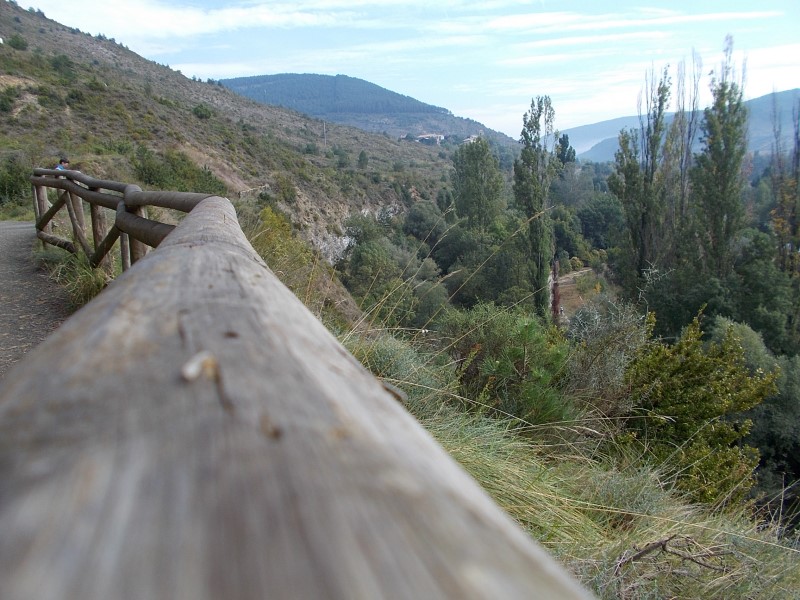 – One of the many viewpoints along the beautiful river path from Zubiri, following the river Arga. You climb then descent then climb again, but it is definitely worth it.
– One of the many viewpoints along the beautiful river path from Zubiri, following the river Arga. You climb then descent then climb again, but it is definitely worth it.
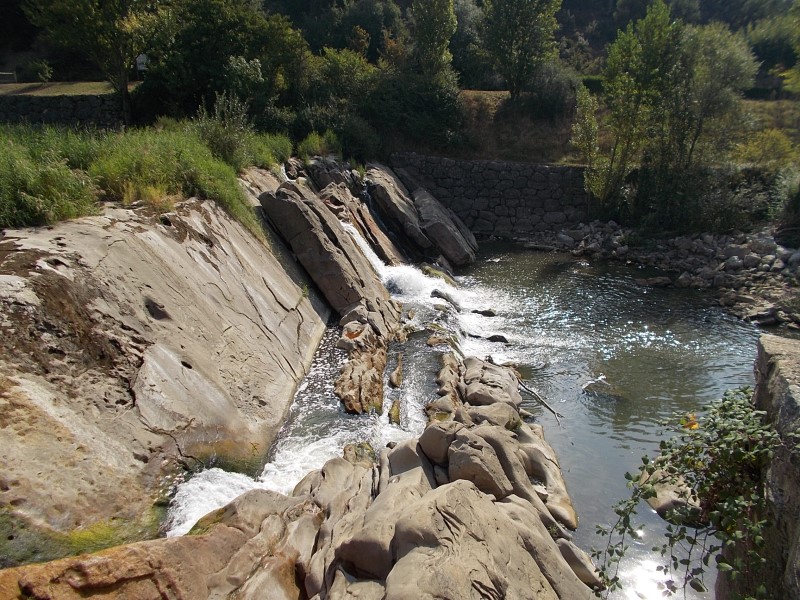 – Just enjoying the river Arga, the sun, the flow, the colors. Life’s beautiful on the Camino, isn’t it? 🙂
– Just enjoying the river Arga, the sun, the flow, the colors. Life’s beautiful on the Camino, isn’t it? 🙂
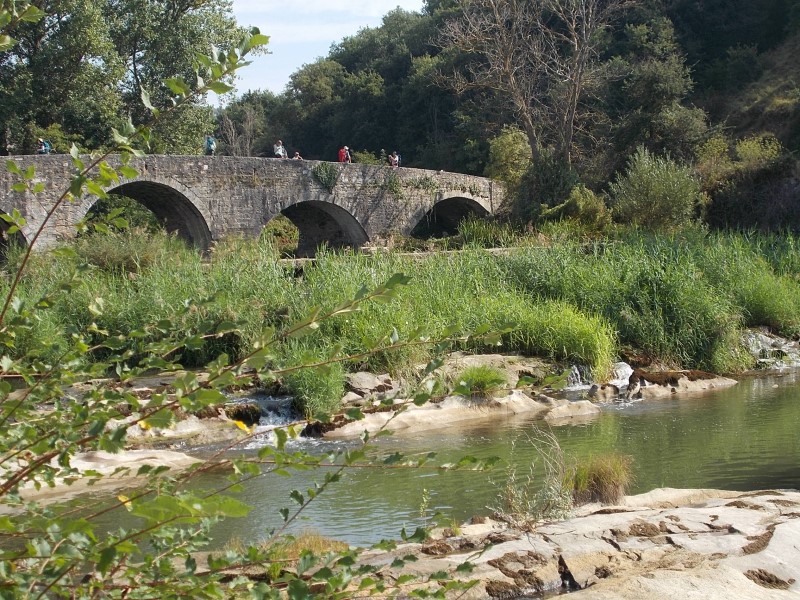 – One of several bridge crossings on today’s hike.
– One of several bridge crossings on today’s hike.
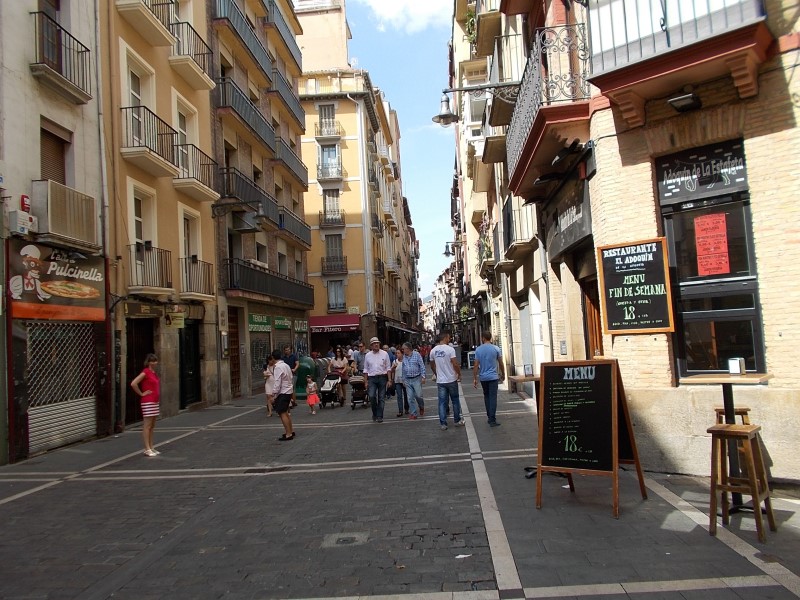 – Pamplona, during siesta hours. That’s your best bet to enjoy the town with streets not being totally overcrowded.
– Pamplona, during siesta hours. That’s your best bet to enjoy the town with streets not being totally overcrowded.
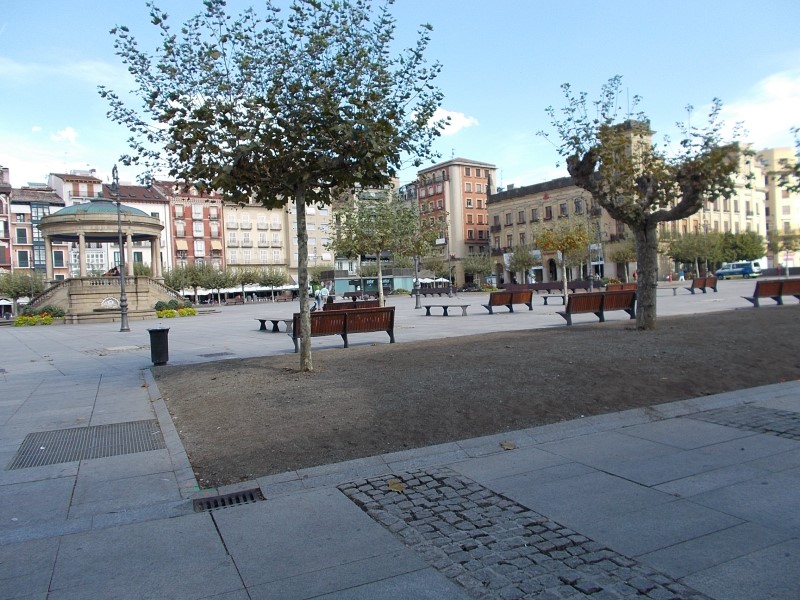 – One of many nice squares of Pamplona
– One of many nice squares of Pamplona
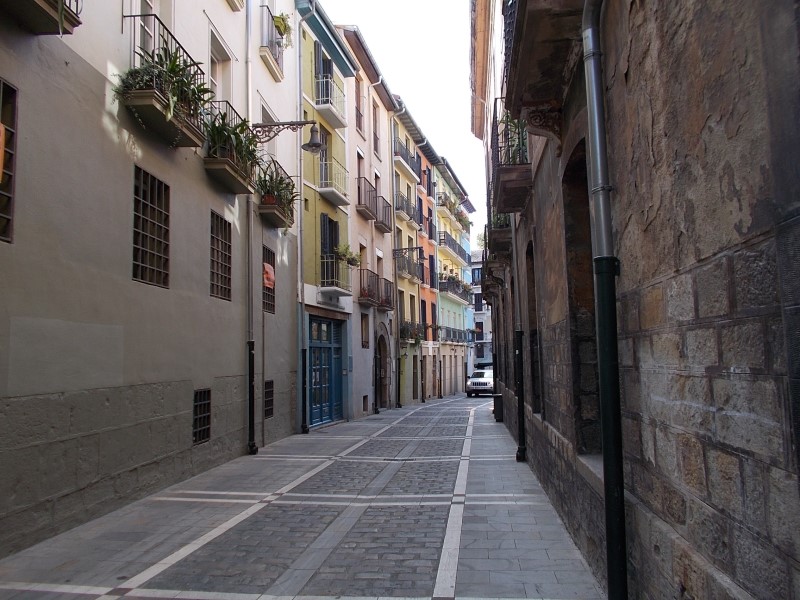 – And yet one more from Pamplona, from a nice side street. I almost cannot believe I managed to take this one with no other people being on the picture 🙂
– And yet one more from Pamplona, from a nice side street. I almost cannot believe I managed to take this one with no other people being on the picture 🙂
Few Tips at the End
- The third critical day. Experienced hikers and pilgrims generally agree that the third day of any multi-day adventure is a critical one. You do not have the adrenaline and enthusiasm of starting something new anymore (the first day), and your body has not accustomed to the weight of the backpack yet (it will happen soon, don’t worry). Maybe a first nasty blister appears on one of your feet, and maybe it even rains. If you feel rather bad on this stage, you should know it is something completely normal. Your daily routine is changing a lot, and you haven’t got used to it yet. Try to get to Pamplona nevertheless, treat yourself with nice lunch/dinner or some good ice cream, and just accept situation as it is. Things will get better from day four :).
- Pamplona gets supper crowded from spring to autumn, especially on days with nice weather. And by super crowded I mean super crowded–on weekends you may sometimes find it hard to walk the streets or get ANY table in any restaurant. This should not discourage you, however. Things will get much better because leaving Pamplona you leave the tourists behind as well. And if you want to enjoy a bit of town without hitting into people everywhere, head out during the siesta hours, for example between 1pm and 4pm. That’s your best bet to have the streets at least a bit for yourself…
- Do not fall for tourist trap with pinchos. If you want to try the famous finger foods, the “pinchos”, I recommend you staying away from the bars and restaurants on the main streets and squares. Any random place on some side street, where you’ll see locals eating and enjoying beer or vine with some pinchos, will serve better finger foods, and often for half the price. If you speak Spanish, you can even ask locals for recommendations. The most popular places on the main streets are never the best and they are also incredibly crowded in Pamplona. Do not fall for this tourist trap.
Next/Previous Stage
- Next stage: Camino Frances Stage no. 4, Pamplona – Puente de la Reina.
- Previous stage: Camino Frances Stage no. 2, Roncesvalles – Zubiri.



![Ultralight Packing List for Camino de Santiago [2025 Edition]](https://caminolovers.com/wp-content/uploads/2022/03/altra-shoes-640-x-480.jpg)
